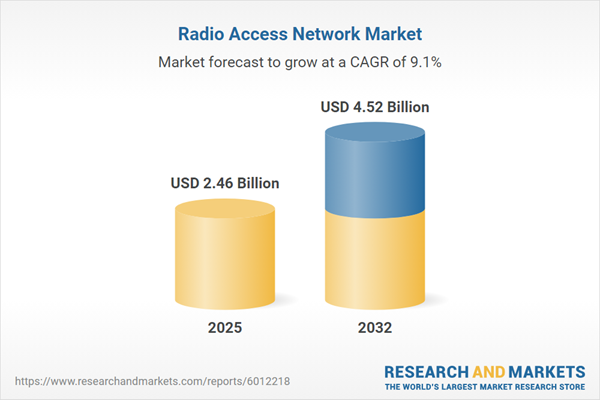Speak directly to the analyst to clarify any post sales queries you may have.
Senior telecom leaders are navigating a dynamic radio access network (RAN) landscape, where strategic foresight and agile execution are essential. As connectivity demands accelerate across enterprises and markets, market intelligence aligned to industry realities provides a critical advantage for decision-making.
Market Snapshot: Radio Access Network Market Analysis
The global Radio Access Network market is projected to achieve USD 2.25 billion in 2024, rising to USD 2.46 billion in 2025, driven by a compound annual growth rate (CAGR) of 9.09%. Growth stems from persistent advancements in wireless technology, heightened enterprise mobility priorities, and a surge in network spectrum investment. Telecom operators are accelerating 5G rollouts, modernizing infrastructure, and adapting business models to remain competitive. Operational agility and cost efficiency are now central to success, while regulatory shifts require organizations to stay responsive to evolving market changes.
Scope & Segmentation of the RAN Market
- Technology: Addresses present and future wireless platforms that support efficient network transitions and scalable bandwidth. Organizations benefit from advanced wireless protocols, essential for maintaining high performance and reliable connectivity as environments evolve rapidly.
- Component: Includes infrastructure such as omni and directional antennas, remote radio units, centralized and distributed baseband systems, and innovative solutions like Massive MIMO. These components are core to achieving consistent, high-capacity networks in both dense urban settings and mission-critical deployments.
- Deployment Type: Encompasses indoor small cell setups designed for complex enterprise sites and expansive macro deployments that ensure seamless service in urban and rural locations. Flexible deployment strategies support uniform user experiences in any coverage scenario.
- Geography: Encompasses a broad global perspective with analysis across the Americas, Europe, Middle East and Africa, and Asia-Pacific. Special attention is given to developments in the United States, United Kingdom, China, and India, where market direction is shaped by local regulatory, adoption, and investment dynamics.
- Key Vendors: Profiles leading industry providers such as Huawei, Ericsson, Nokia, Samsung Electronics, ZTE, Cisco Systems, NEC, Fujitsu, Mavenir, and CommScope, highlighting their roles in expanding product portfolios and driving partnerships that influence broad client segments.
Key Takeaways: Strategic Insights and Technology Trends
- Software-defined RAN architectures deliver enhanced network flexibility, empowering decision-makers to dynamically adjust infrastructure based on changing service requirements and workloads.
- Cloud-native and virtualized approaches offer faster operational responses, making it easier for providers to keep pace with shifting user expectations and telecom standards.
- Open network interfaces improve interoperability, streamlining integration among diverse vendors and minimizing technical barriers in multi-vendor environments.
- Advancements such as beamforming and Massive MIMO increase reliability and service quality, particularly in locations with high user density or business-critical functions.
- Small cell deployment addresses network capacity and coverage challenges, benefiting enterprise clients and end-users through uninterrupted wireless access.
- Industry collaborations and AI-enabled management tools equip operators to monitor network health, optimize performance, and identify new growth opportunities as the market transforms.
Tariff Impact and Supply Chain Resilience
- Recent tariff adjustments in the US have prompted telecom organizations to reassess sourcing strategies, leading to adoption of models that prioritize cost management and supply chain control.
- Relocating production sites and emphasizing local assembly enhance supply chain dependability, supporting agile responses to ongoing trade and logistics uncertainties.
- Expanding regional manufacturing capabilities and building strong supplier relationships boost resilience, enabling operators to maintain business continuity in the face of regulatory disruptions or sudden market changes.
Methodology & Data Sources
This Radio Access Network market analysis is based on direct interviews with network providers, suppliers, and leading industry analysts. The data was validated using regulatory filings and technical documentation to ensure credible, actionable recommendations tailored to the needs of telecom sector decision-makers.
Why This Radio Access Network Report Matters
- Provides actionable market intelligence for aligning leadership strategies with changing technology paths and regulatory complexities.
- Clarifies the influence of policy and innovation on risk management and investment choices, supporting informed and proactive decision-making.
- Enables organizations to anticipate shifting risks and maintain agility, strengthening readiness across evolving telecom infrastructures.
Conclusion
As the RAN sector continues to evolve, senior decision-makers benefit from timely, targeted analysis and practical insights. This approach enables effective responses and drives organizational strength in an ever-shifting telecom landscape.
Additional Product Information:
- Purchase of this report includes 1 year online access with quarterly updates.
- This report can be updated on request. Please contact our Customer Experience team using the Ask a Question widget on our website.
Table of Contents
3. Executive Summary
4. Market Overview
7. Cumulative Impact of Artificial Intelligence 2025
Companies Mentioned
The companies profiled in this Radio Access Network market report include:- Huawei Investment & Holding Co., Ltd.
- Telefonaktiebolaget LM Ericsson
- Nokia Corporation
- ZTE Corporation
- Samsung Electronics Co., Ltd.
- Cisco Systems, Inc.
- NEC Corporation
- Fujitsu Limited
- Mavenir Inc.
- CommScope Holding Company, Inc.
Table Information
| Report Attribute | Details |
|---|---|
| No. of Pages | 188 |
| Published | October 2025 |
| Forecast Period | 2025 - 2032 |
| Estimated Market Value ( USD | $ 2.46 Billion |
| Forecasted Market Value ( USD | $ 4.52 Billion |
| Compound Annual Growth Rate | 9.0% |
| Regions Covered | Global |
| No. of Companies Mentioned | 11 |









